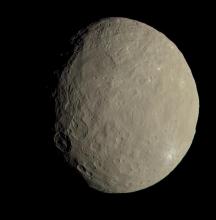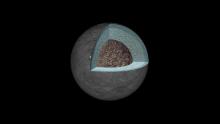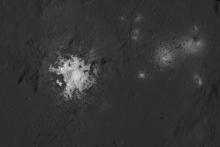Listen to today's episode of StarDate on the web the same day it airs in high-quality streaming audio without any extra ads or announcements. Choose a $8 one-month pass, or listen every day for a year for just $30.
You are here
Hospitable Ceres?
Ceres doesn’t look especially hospitable. The solar system’s biggest asteroid has no atmosphere, and its surface is covered by impact craters — a landscape that looks as desolate as the Moon.
But things aren’t always what they seem. The top layer of dirt and rock on Ceres appears to be mixed with a large amount of frozen water. Liquid water may lie below the surface. And organic compounds have been detected on Ceres as well — some of the basic building blocks of life.
The Dawn spacecraft has been orbiting Ceres for more than two years. Its earliest pictures revealed some brilliant white spots on the surface. The spots are deposits of salts. Impacts by big space rocks may have cracked the crust, allowing salty water to bubble to the surface. The water quickly evaporated, leaving behind the salt.
The craft also has photographed several types of landslides on Ceres. The contours of some of the landslides resemble the aftermath of avalanches here on Earth — a mixture of ice and rock. Others look like they were made by a mixture of rock and liquid water; impacts may have melted some of the ice near the surface, forming a muddy sludge that flowed downhill.
Dawn also has found organic compounds on Ceres. Those chemical building blocks may also have come from inside Ceres, just as the water did.
So Ceres has some of the key ingredients for life — perhaps making the little world more hospitable than it looks.
Script by Damond Benningfield






